 |
Little Golem FREQUENTLY ASKED QUESTIONS Last Update: April 11, 2020 |
 |
 |
Little Golem FREQUENTLY ASKED QUESTIONS Last Update: April 11, 2020 |
 |
Little Golem is a turn-based game server! A turn-based server allows you to play games against players who may not be online at the same time you are. Games usually take several days or weeks to complete. In fact, games lasting many months are not uncommon. Most of the games available are two-player abstract strategy
(perfect information) games. |
|
Currently there are 28 different games. Note that several games (Dots and Boxes, Four In A Row, Go, Havannah, Hex, Lines Of Action, Morelli, Polyonimo, Reversi, Shogi, and WYPS) are available on more than one board size! The available games, listed
alphabetically, are: |
|
|
|
|
|
| A very brief description of each game follows. |
|
|
Amazons - Played on a
10x10
board, players alternate turns which consist of moving one of
their four "amazons" and
shooting an arrow. Arrows act as a type of a "blocker"
for the remainder of the game - future moves and arrows cannot pass over
arrows on the board. The first person unable to move, loses! Amazons was invented in 1988 by Walter Zamkauskas of Argentina. |
|
|
|
|
|
|
|
Breakthrough - Played on an
8x8 board, the object of the game is to be the first player to maneuver
one of their pieces to their opponent's back row. Each piece
may move to any empty square that is either one space diagonally or
straight ahead. Pieces may capture opposing pieces just
like a chess pawn - if the opposing piece is one space diagonally
forward. Breakthrough was invented in 2000 by Dan Troyka and won the 2001 8x8 Game Design Competition. |
|
|
|
|
|
|
|
Catchup - The object of the game is to
own the largest group of stones at the end of the game, when the board
is full. A group of stones is a set of one or more connected
like-colored stones. Each player alternates placing one or two stones on an empty space on the game board. If your opponent improved on his last move (took the lead, extended his/her lead, or caught up to your score), you get to play three stones this turn! Note that as you get closer to winning, your opponent gets more powerful! Catchup is about timing, position, and the the interplay between them. In addition to the standard board, Catchup can also be played with a random board. Catchup was invented by Nick Bentley and was a finalist in the Thousand-Year Game Design Challenge. |
|
|
|
|
|
 |
Chess - Arguably,
chess is almost certainly the most
popular board game on the planet during the past 200 years. There is more
literature on chess than all other games combined. Checkmate your
opponent's king and win the game! Chess960, also known as FischerRandom Chess, is also available! |
|
|
|
|
|
|
|
ConHex - The object
of ConHex is to complete a continuous chain of connected cells
between the player's two colored sides of the board. ConHex is a
connection game and thus can be considered a cousin to Hex and probably
a distant cousin to Twixt. Players alternate placing stones of their color on a vertex. A player can claim a space as their own after placing stones on at least half of the vertices surrounding that space. ConHex was invented by Michail Antonow. |
|
|
|
|
|
|
|
Connect 6 - The object is to
get six or more or your stones in a row, either horizontally, vertically, or
diagonally. Black begins the game by placing one Black stone on
the board and then play alternates with each player placing two stones
of their color on the board each turn. Once placed, stones are
never moved nor captured. Connect 6 was invented by Professor I-Chen Wu. |
|
|
|
|
|
 |
Dots and Boxes - This
is the same popular pencil and paper game you probably played as a child. Players take
turns connecting lines on a 5x5
grid. Complete the fourth side of a
box and claim that box as your own! After all of the boxes have
been claimed, the player with the most boxes wins! Dots and Boxes can be played on several size boards. (4x4, 5x5, 6x6, and 7x7.) |
|
|
|
|
|
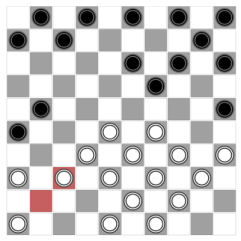 |
Draughts / Checkers English Draughts, often known as American Checkers, is played on the dark squares of an 8x8 board. Players alternate making moves with their pieces. A player loses the game if all of his pieces are captured or he cannot make any move with his pieces. International Draughts is played on the dark squares of a 10x10 board. As with English Draughts, players also alternate making moves with their pieces, but the pieces behave a bit differently than they do in English Draughts. (Backward captures are possible, for example.) Dameo is an checkers variant played on an 8x8 board. The starting arrangement is different and all 64 squares are used. Dameo was invented by Christian Freeling, who also invented Havannah.
|
|
|
|
|
|
|
|
DVONN - Released in 2001 by
Kris Burm as the fourth game of the GIPF project, DVONN is a challenging
stacking game with very simple rules. The object is to
control more of the playing pieces than your opponent at the end of the
game. Players alternate turns by moving stacks of pieces they
control. During the game,
pieces and stacks must remain linked to the red Dvonn pieces. If not,
they are removed from the board. Note: Rated Tournament and non-rated games are played with a random start position - the opening "setup phase" is skipped. Championship and Monthly Cup games all start with an empty board - the setup phase is not skipped. |
|
|
|
|
 |
EinStein würfelt nicht! - Played on
a 5x5 grid, each player controls six cubes, numbered
1 through 6. Players
alternate rolling a six-sided die and then moving their appropriate
cube. If the matching cube is no longer on the board, the player
moves a remaining cube whose number is next-highest or next-lowest to
the rolled number. You win a "leg" (or a
"set") if you move one of your cubes to the far
corner of the grid, or if your opponent is unable to move. The
first person to win three "legs" ("sets") wins the game.
Alternately, games can be the best of 1, 5 or 7 legs. Variants
include "Backwards Capture" and "Black Hole." EinStein würfelt nicht! was invented by Professor Dr. Ingo Althofer. |
|
|
|
|
|
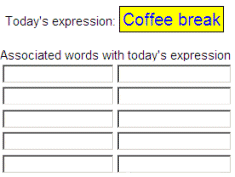 |
Empathy - Empathy is
currently the only multi-player game at this site. In the past, more than 90 different players
have taken
part in each game! With a given expression, you must list ten other words (or phrases) that you believe are in association with the given expression. Points are awarded for each answer based upon how many other players answer identically! The player with the most points is the winner. A new game is currently played every three days. Warning to parents! There is no moderation. Both the expressions and the answers might be considered inappropriate for young children. (In an effort to answer identically, players often overlook the first rule - to list words or phrases that are in association with the given expression. Answers often have nothing to do with the given expression.) A countdown clock informs you when the next game will begin. Please note that ANY discussion on the current game in the forums is strictly frowned upon. |
|
|
|
|
|
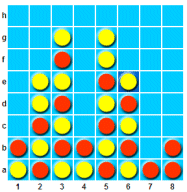 |
Four In A Row - Players alternate
dropping their own checkers into an 8x8 grid. The object is to
line up four or more of your checkers in a row in any direction; horizontally,
vertically, or diagonally. The 8x8 size board is show, but Four In A Row is available in several sizes. (6x7, 8x8, 9x9, and 10x10) |
|
|
|
|
|
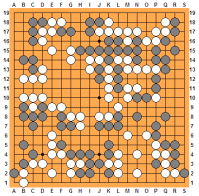 |
Go - Now popular throughout the world, Go originated in ancient China, possibly as early as 500 B.C. Despite the simple rules, it is said Go is many times deeper and more complex than chess. Players alternate placing stones on a grid, attempting to control more territory than their opponent. Go is available in three different board sizes; 9x9, 13x13, and 19x19. | |
|
|
|
|
 |
Gomoku - Played on a standard
19x19 Go
Board, the object
is to form an unbroken row of five or more stones horizontally, vertically, or diagonally. Once played,
stones are never moved nor captured. Opening restrictions reduce
Black's first-move advantage. Gomoku Pro (15x15 and 9x9) Gomoku Pro begins differently than Gomoku and contains a no-draw rule. The first player may play 1,2,3,4, or 5 moves. The second player continues the game with the next stone, or may swap sides. The first player who can pass all of his remaining moves is the winner. |
|
|
|
|
|
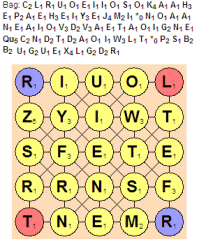 The word list used for verification is the SOWPODS word list. |
Golem's Word Game - A game unique to
this site. After bidding for the right to go first, players
alternate turns by finding words in a 5x5
letter-grid. Points are scored for
each word, based upon the specific letters in the word, the length of the word,
and the location of the word on the grid. Letters used are replaced with letters from an open
and known pool of existing letters. The object is to score more
points than your opponent after all of the letters have been used. To help speed up the initial stage of the game, the bidding process, the game has an auto-bidding feature. (The bidding process is necessary because if a very high-scoring word was found in the initial grid, the first-player would, of course, have a decisive advantage.) Because bids are in half-point increments and the remaining scoring in full-point increments, a Golem Word Game can never end in a tie! |
|
|
|
|
|
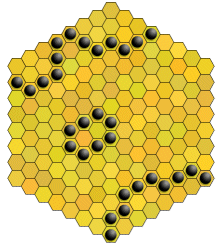 The above board is a base-8 size board, but Rated Tournament Games are also available with a base-10 size board. |
Havannah -
Invented by Christian Freeling, Havannah is a "connection
game" and can be considered a 'cousin' to both Hex and Twixt. Players alternate placing stones of their own color on a hexagonal board. Once placed, stones are never moved nor captured. Each player attempts to be the first to form any of three different types of "chains" - a ring, a bridge, or a fork. All of these chains are closed connections of the same color. A ring is a continuous loop around one or more occupied or unoccupied cells. (The occupied cells can be of either color.) A bridge is a connection involving any two of the six corners. A fork is a connection involving three of the board's edges. (Note that a corner is not considered part of an edge.) The diagram to the left shows examples all three of these different types of winning conditions. Currently, all base-8 size boards are being played with the swap rule. |
|
|
|
|
|
 The board above shows a 13x13 game in progress but Hex is also available with an 11x11 and a 19x19 board. |
Hex - Invented independently
by mathematician Piet Hein and then later by
mathematician John Nash, Hex
is a "connection" game. Players alternate placing stones
on a board consisting of hexagons, each attempting to connect their two sides
together. Once placed, a stone is never moved nor
captured. Because the player moving first has an advantage, the swap rule (in effect) is used to help equalize the game. Hex can never end in a tie. If a game's worth can be estimated by its strategic depth versus rule complexity, then hex provides excellent value. It's extraordinarily complex, yet with a rule set among the simplest of any game possible! |
|
|
|
|

The board above shows the initial position but games can also be played with the Scrambled Eggs Start variation (all 32 checkers alternate in color) or the Quick Start variation (just eight pieces per color, four on each side). |
Lines of Action - Invented by
Claude Soucie, Lines of Action is played on an 8x8 board. Each player
controls 12 checkers of their own color.
The object is to bring all of your checkers together into one continuous body, either horizontally, vertically, or diagonally. This is done by repositioning them on the board via moving and jumping, capturing opposing checkers, etc. Championship 15 is being played on a 9x9 board size, with the center square a black hole! When a stone lands on the black hole, it disappears! |
|
|
|
|
|
 |
Morelli - Named for a
character in Juli Cortazar's novel Hopscotch, Morelli is played
on a board divided into 13x13 squares, and colored in concentric bands
with the successive shades of the rainbow; red, orange, yellow, green,
etc. Two players, Black and White, alternate turns making "inward Queen-moves" one piece at a time. The object is to occupy the middle square, called the Throne, with the "King" of one's own color by centering a frame upon it, a rotationally-symmetrical arrangement of four friendly pieces at any distance. The occupant of the Throne at game’s end is the winner. Note that a stone flanked b two adverse stones switches color and now belongs to the other player. Morelli can also be played on a 9x9 and an 11x11 board. Morelli was invented by Richard Moxham. |
|
|
|
|
|
 |
OSKI -
OSKI is a word game played on a board consisting of 19 hexagons.
Players alternate turns by placing a letter on the board, forming new
words. The number of letters in the length of the new word you
formed is the number of points you earned for that move. The
player with the most points at the end of the game is the winner.
Since the initial word always consists of three letters, all games last exactly 16 moves. |
|
|
|
|
|
 |
Polyomino -
Golem's latest game, Polyomino, can be played on four different
board sizes! Players alternate turns, placing their pieces,
polyominos, on the board. Pieces played must touch other pieces of
their own color but only at the corners, not the edges. If a player cannot play any pieces, they must pass, and after two consecutive passes the game is finished. The player with the most squares on the board is declared the winner. To offset any possible first person advantage, the game is played with a swap rule. The graphic to the left depicts a finished game, on a 14x14 board. Blue won, the game, with 70 squares to Orange's 66 squares. |
|
|
|
|
|
 |
Reversi - Reversi, (known commercially as Othello) is available on both an 8x8 and 10x10 board. Players alternate moves by placing a disc of their own color on the board, and "flipping" opposing discs, turning these discs into discs of your own color. The object is to have more of your discs than that of your opponent at the end of the game. The initial position is shown in the diagram. | |
|
|
|
|
 |
Shogi -
Also known as Japanese chess, Shogi is a two-player board game belonging
to the same family as Western chess, chaturanga, and Chinese Xiangqi.
Perhaps the enduring popularity of Shogi can be attributed to the 'drop rule' - captured pieces can later be returned to the board to be used as one's own! The image shown to the left is the official size board, but Mini-Shogi is also available. Note that alternate board images are available to players using the Chrome browser. |
|
|
|
|
|
 |
Slither - Invented by Corey Clark,
Slither is a connection game and can be considered a cousin to Hex.
Player's alternate placing and/or moving stones on the board in an
attempt to connect their two sides orthogonally. Black attempts to
connect the top and bottom edges, while White attempts to connect the
left and right edges.
A game of Slither cannot end in a draw. |
|
|
|
|
|
 |
StreetSoccer - As the name implies, StreetSoccer simulates a soccer
game. Players alternate rolling a die, moving their soccer players on the
field appropriately, attempting to score more goals than their opponent. StreetSoccer was invented by Corné van Moorsel. |
|
|
|
|
|
 |
TwixtPP - The
game Twixt
was invented by Alex Randolph and like Hex, is a "connection" game.
Players alternate placing pegs on the board. Pegs placed "a knight's
move apart" are linked together. Each player attempts to
connect both his sides together, while preventing his opponent
from doing the same.
Unlike Hex, it is possible
for a Twixt game to end in a draw. TwixtPP is played here with the swap rule. |
|
|
|
|
|
 |
TZAAR - The most recent
game of the GIPF project (replacing TAMSK), TZAAR is a mix of mix of
capturing and stacking. In the initial phase of the game, players put their pieces on the board one at a time in any order they choose. After this, the players take turns emptying the board. A player must make two moves; first capturing an opponent's piece and then either capturing another piece or strengthening their own pieces by stacking them. The question each player must ask themselves on each turn is, "Do I make myself stronger or do I make my opponent weaker?" When a players loses all of one type of piece (tzaars, tazrras, or totts) or if a player is unable to capture a piece in the first part of their move, they lose. TZAAR was the 2009 Games Magazine Game of the Year winner and was created by Kris Burm. |
|
|
|
|
|
 In the above position, Black won the game by placing the letters R-I-T next to an existing E, forming the word RITE. The E was a White letter prior to the move, but when Black used it to help form his word, it became a Black letter and helped to form a connection to all three sides of the board. The above board is a base-10 size board, but WYPS can also be played on several other board sizes. |
WYPS -
Invented by Richard Malaschitz, two players, Black and White, alternate turns by placing letter tiles from a common
'rack' on a triangular board made up of hexagons. Letters used from the
rack
are replaced from a known pool of four existing letters. Random letters from a bag replace
the four pool letters. The letters placed on the board must help form a new word. The word list used for verification is the SOWPODS word list. Unlike Scrabble, letters that touch existing letters already on the board do not have to form a word. All letters placed on the board from the
rack become
that player's color. Also, if the player on move used one or more
of his opponent's colored letters to help form a word, that player can
choose one of these letters to turn into his own color! |
|
Several of the above games can be played on
different board sizes, as mentioned above. Other games can be
played with different sizes that weren't mentioned above. For example, Havannah is available on a
seven different size boards! (Base 4 through Base-10.) Dots
and Boxes can be played on a four different size boards. Go has several variants including
a vey large 37x37 size board, a variation known as Toroidal, a 19x19
Hahn point system, and a 19x19 Random 100 (in which 50 White and 50
Black stones are randomly placed before the game begins). Gomoku has two variants - Gomoku 9x9 and Gomoku 15x15. Both of these games begin differently than Gomoku, and contain a special no-draw rule. |
|
You can...
|
|
The time limit is usually expressed as 240/36. This means you initially have 240 hours (ten days) to make each move. After each move you make, an additional 36 hours is added to your time, up to a maximum of 240 hours. Example: A new game begins. Each player has 240 hours for
each move. Your opponent was online when the game began and moved
immediately. You sign on four hours later. Your time
available to make a move has dropped to 236 hours (240 minus 4). If you
move now, you will again have 240 hours to make your next
move. (36 hours are added to your time, with a max of 240.) In addition, each player also has vacation days, which kick in automatically if a player's available time runs out. Each player has the equivalent of 15 (or 20) vacation days each year. (Paid members have 30 vacation days.) Each player's vacation days are reset on January 1st of each year. You can view the number of vacation days you have remaining by clicking on the MYGAMES link from the main menu, and then clicking on VACATION. If the player on move does not move, and
this player has all of their vacation time remaining,
a game can last approximately one month... an initial 240 hours to make
a move (10 days) + 15 or 20 vacation days. At this point the system will
automatically end the game. |
|
No to both questions. There is no
limit on the number of games you can play at one time, but new players are advised to
begin slowly and not take on more games than they can handle. You
can make as many moves per day as you want. Unlike other
turn-based sites, there is no limit!. |
|
Hex has other board choices you may prefer more than the default choice. When playing or viewing Hex, toggle the Color Scheme button at the bottom of the page. Hex, for example, has five different choices for the board graphic! In the future, other games may also have alternate choices. |
|
To help prevent a player from manipulating
his or her own rating, if you and your opponent are both using the same
IP address, or if you have previously logged in using your opponent's IP address,
the game will not be rated.
|
|
Every player has a rating graph for every
game they've played, similar to the example shown below, that gives a history
of how their rating has changed over time. To view the rating
graph for you or any other player, click the tiny graph icon
|
|
The four tournaments are not related to each other. Winning
a game or a tournament in one type does not advance you to another.
Monthly Cup, Championship, and User tournaments all use a Round Robin format... you play against everyone else in that
tournament. In the case of Monthly Cup and Championship
Tournaments, you play one game against everyone else. In a User
Tournament, you may play two games against each player, if that
tournament was set up that way. Because of the additional rounds, Monthly Cup
Tournaments take much longer to finish than Rated Tournaments, often
many months to complete. Depending upon the game and the number of
players, the Monthly Cup Champion for the month of, for example,
February, might not be determined until August!
|
|
Monthly Cup Tournaments will start approximately ten minutes
after the fifth person signs up. And as mentioned above, Championship Tournaments begin
one week after all games from all leagues have been played in the
previous Championship. User Tournaments will start at
the scheduled start date, as set by the member who created the
tournament.
A new Infinity Tournaments
starts every two weeks, approximately. |
|
If you're interested in playing a single game you can post a request for a game, or respond to someone else's request for a game, in the Waiting Room. The Waiting Room consists of both rated and unrated games. If you see an unrated game you'd
like to play, click the word ACCEPT next to the player's name. If you'd like to post
your own request for a game, click the ADD link in the far right
column. If you post a game to the waiting room and wish to
remove it, click the REMOVE link next to your request. |
|
For many years each message in your Inbox was stored for exactly two months. At the end of two months, the message was automatically be deleted by the system. Currently however, it appears Inbox messages are being stored for at least three years. |
Son is short for Sonneborn-Berger. It's a scoring system used to break ties. As an example of how this tie-breaking system works, please note the results for League #1 of the 9th Chess Championship Tournament, located in this cross table:  Notice that both kali and Horst DOG finished the tournament with five wins, three draws, and zero losses, for a total of 13 points. (In all games, each win scores two points and each draw scores one point.) However, kali, with 90 Son points, had the better Son tiebreaker, and thus was declared the tournament champion. A player's Son total can be arrived at in the following manner: Add up the final point total of all the players he defeated, add up one-half of the final point total of all the players he drew, add these two figures together and then multiply the entire result by 2. Here's an example: By the crosstable above you can see that joerg defeated Players 7, 8, and 9 who finished the tournament with 6, 4, and 0 points respectively. Adding these three points gives us 10 points. (6 + 4 + 0 = 10 points.) Joerg drew with players 1, 2, 3, 5, and 6, who finished the tournament with 13, 13, 12, 7, and 6 points respectively. Adding one-half of each of these points gives us 25.5 points. (6.5 + 6.5 + 6 + 3.5 + 3 = 25.5 points.) 10 points + 25.5 points = 35.5 points. 35.5 points multiplied by 2 = a Son score for joerg of 71. It is important to realize a player's Son score is only used to break ties. Even though joerg had a higher Son score than BigChicken, BigChicken finished in 3rd place, with 12 points, which was higher than joerg's 4th place finish, with 11 points. Sonneborn-Berger is actually something of a misnomer. William Sonneborn and Johann Berger were actually strong critics of the scoring system! The system really should be called the Neustadtl score! More about how the Sonneborn-Berger tie-breaking system can be found here: http://en.wikipedia.org/wiki/Sonneborn-Berger. |
|
Each game has its own forum section. If you have a question of comment about a specific game you should post it in that game's forum. If you have a general question or comment about the server, or a question or comment not related to any specific game, you should post it in the main forum. To help prevent spambots from automatically posting ads in the forum, a player is now required to play approximately ten games before being allowed to post in the forum. Player's can delete their own forum
posts.
To include a tournament table use this syntax:
|
|
Yes. From the menu in the left column, click on MAIN and then EDIT USER PROFILE. Note: Regarding your user profile... for awhile it was recommended you save to a text file any information you submit in the MORE INFO text box. There was a time when the system would regularly "reset/reboot" itself and when it did the user profile information was retrieved from an earlier source... meaning recent changes you may have made to your user profile were now lost and would not be seen. If you saved your information to a text file you could easily submit it again the next time the system was reset/rebooted. However, this tip is no longer necessary... the "reset bug" appears to be fixed. (Still, it's not a bad idea to save this information anyway.) |
|
Register at gravatar.com using the same e-mail address you used when you registered on this site. Change you image/avatar there. Log off of Little Golem and then log back in. That's it! |
Paid members receive extra vacation days, the ability to post longer blogs, the ability to post a larger number of Waiting Room game requests, and the ability to create User Tournaments. In the future, paid members may receive additional benefits. In the forum section, members can be identified by the star next to their name.
Yearly membership is currently 19 EUR. (Approximately $20.78 USD,
as of April, 2020.) Payments can be sent via PayPal. To
initiate the process, click MEMBERSHIP from the main menu. |
From the menu in the left column, click on MAIN and then LOG OFF. It is only necessary to log off if you are using a public computer or otherwise share your computer with others. If you are the only one who uses your computer, logging off is not required or necessary. If you wish to quit the site completely or if circumstances dictate you are unable to continue making moves in your games for an extended period of time, you should... 1) ...resign all of your current games and 2) ...remove yourself from an automatic signup of all future Championship Tournaments. (From the menu in the left column, click TOURNAMENTS and then in the Championship column click REMOVE ME.) Your name and password will remain valid if you wish to play games in the future. |
|
There are several reasons why it might be beneficial to keep your account. For example you may be tired of playing games here now, but it's certainly possible you might wish to play again in the future. It's also possible the server might some day implement a new game you are interested in. If so, you can resume playing with your old account and you won't have to create a new one. Finally, by keeping your account you can continue to read and post questions in the forum section. Please note that if you decided you don't like your screen name, you can choose another one! To do this, from the Main Menu click on MAIN and then EDIT USER PROFILE and then enter a new name in the box marked Your real name (visible for others):
|
In 2006, several players decided to create and participate in a Little Golem tournament of their own. The tournament was a round robin format... every player would play every game offered at Little Golem against everyone else in the tournament! Discussions were held in the forum section on the tournament format, length of tournament, rules, etc. The winner would be given the title of Monster of Little Golem. The first tournament took almost a full year to complete and was won by Ray Garrison. The second tournament recently finished and Ray Garrison was again the winner. A couple of players created websites with stats and results about the tournament. ypercube's website can be found here and tasuki's website can be found here. |
The swap rule, also often referred to as the pie rule, is the name given for a method to help negate the advantage of moving first. Without the pie rule, games with too large of a first-move advantage would be unfair and thus unplayable. The name comes from the classic example of two people who want to split the last piece of pie. One person cuts the piece into two pieces and the other person gets to choose which of these two pieces they want. This ensures the player who cut the piece of pie will cut it into two halves that are as equal in size as possible. In board games the method is similar. The player to move first makes a move on the board and the second player has the option of either a) swapping sides, so the move made by the first player thus becomes his/her move, or b) continuing the game from this position and making his/her own move. This equalization method ensures the first player won't make too strong of an opening move. If he did, of course, the second player would definitely swap sides! Games that use the pie rule here are Hex, Twixt, WYPS, Slither, and Polyomino, and Havannah. |
The server running Little Golem is located in Europe in the country of Slovakia. All date and times are stamped with the server's local time. Slovakia is in the Central European Time Zone which is one hour ahead of Greenwich Mean Time (GMT +1). (Two hours ahead of Greenwich Mean Time (GMT +2) when Daylight Saving Time is being observed.) |
|
With a minor exception or two, Little Golem has been up continuously since March of 2002. |
|
Back in March of 2014, member terrance806 said, "One of the interesting and quaint things about this site is that it takes years to understand it. Just enjoy the games!" I think that's a very good
observation and good advice!
Enjoy the games and have fun! |
|
Thanks for playing on our website. |